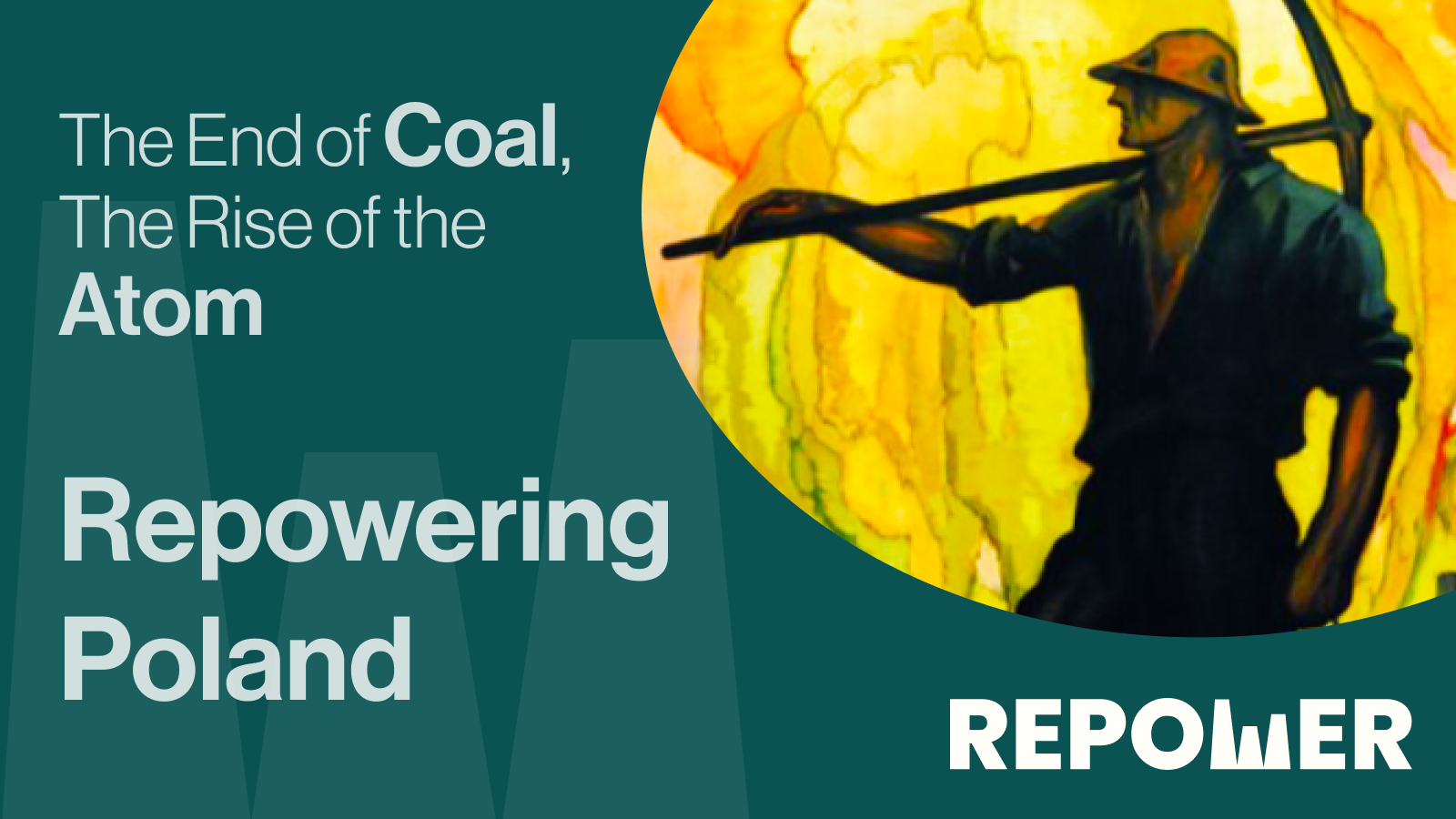
Part I
Down the Mines
Silesia in Poland is the hard-working and coal-powered heart of Poland’s heavy industry. A hospitable, forest-clad region, with wilderness that’s home to eagles and wild pigs, where mining, metallurgy and textile production have been the dominant industries since the Middle Ages. Richly abundant seams of hard coal, lignite, mineral and metal ores have been scooped from various depths of Upper and Lower Silesia for centuries, as first the highest-buried rocks were picked out, and then the strata beneath.
The region became rich off its unburied bounty. Ironworks and zinc smelting sites were built as close as possible to the ore mines, and coal was the heat source of choice for wresting zinc from rock, to be shaped into brass doorknockers and roof cladding and favoured items of former times.
The region was variously administered by vying powers, including the Holy Roman Empire, Prussians and Nazis – all who saw the intrinsic value in this land of gold, silver, copper, iron and lead ores. Coal mining and the industrial scale-up and modernisation it exemplified, became infused with the identity of the region, also through propaganda imagery. Generations of workers headed down the dark and gloomy pit tunnels for the valuable materials, far from the sunlight, returning upwards to their families and communities coated in dust and sweat.
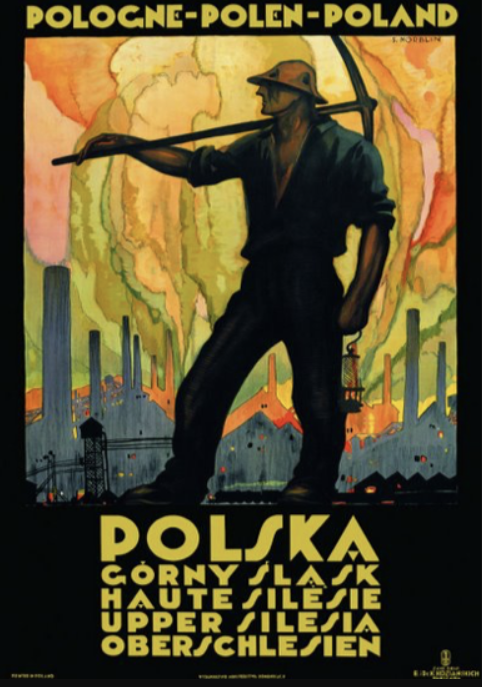
In current times, Upper Silesia is the most densely populated and urbanised region in Poland, with over 4.5 million resident Upper Silesians, and it is still highly dependent on coal power for its industry, energy production and heating.
Coal, that heat source of choice for hundreds of years, that convenient, reliably flammable, rocklike ancient swamp vegetation, proves a tough substance to wean off from. 4 coal-fired power stations and 16 active coal mines employ around 4% of the population in the Upper Silesia region today. Trains and truck loads of coal arrive at the boilers every day. 62.85% of the Polish power sector is made by setting fire to lignite and hard coal and harnessing the clouds of steam that unfurl1. Rock and fire, steam and magnets – there’s a simplicity to combustion which is appealing.
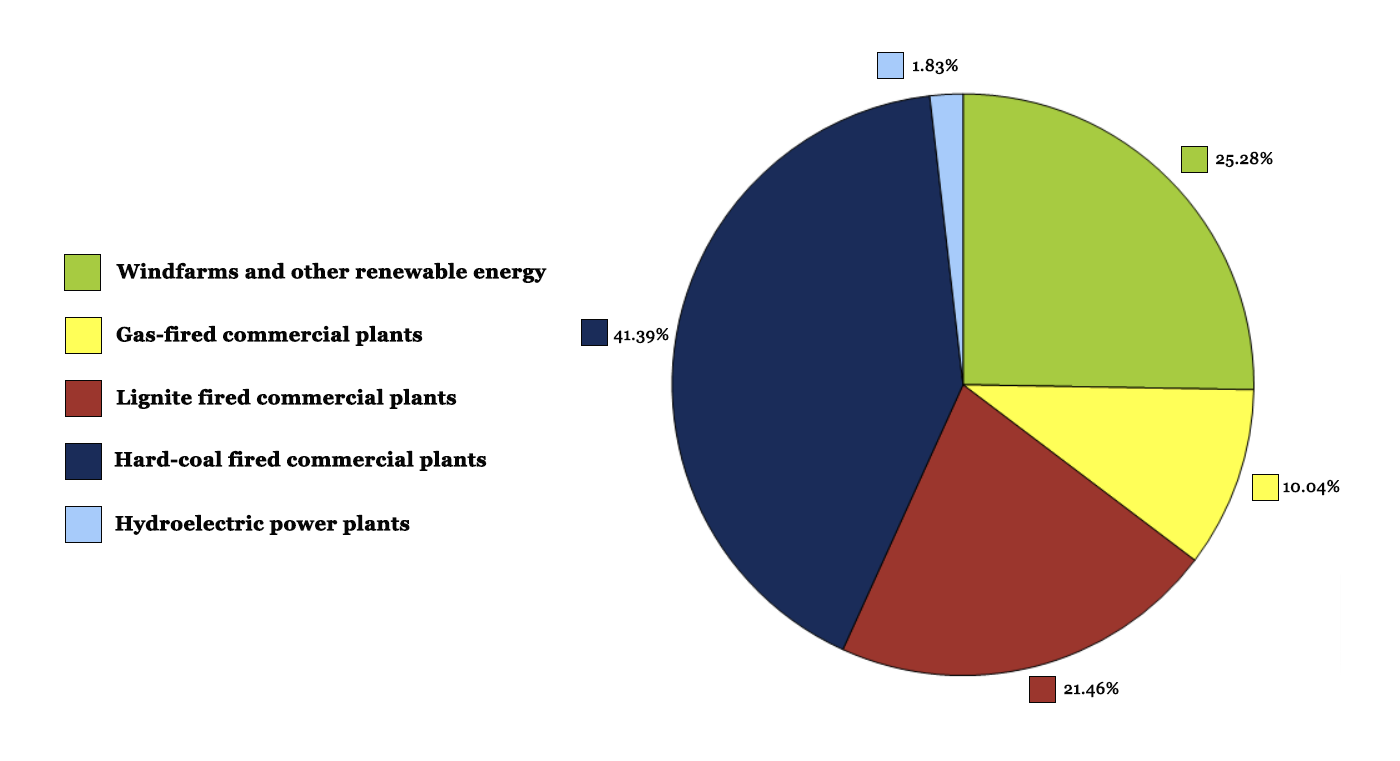
Poland elevated around 88 million tonnes of coal in 20242, predominately unearthed from this region of minerals and metals, mainly by mechanical longwall systems. Roaring, churning machines shear coal from coalface with cutting drums fitted with cutting picks, disintegrating the ‘black gold’ onto conveyors under the auspice of hydraulic ‘chocks’ which keep the roof from caving in on the operation.
They work alongside their human colleagues, who may have taken a bus 50-70km to the mines. Mask-faced, goggled, and ear-defended humans mining alongside machines at depths of 600-1000m, reclaiming organic material which last saw the sun up to 359 million years ago, when the land was waterlogged swamp and primeval forests of mosses and ferns, with giant ancestral millipedes crawling around, as dragonflies with wingspans as wide as pigeons flapped by in iridescent arcs. Dinosaurs were yet to evolve from ambitious amphibians, who were going through the moves of dipping their webbed feet out the waters, and trying out life beyond the aquatic.

Fossil fuel from a long-forgotten land should really remain where unfathomable tracts of time and geologic pressure have placed it on our planet: deep underground. Some 125 billion tonnes of coal reserves are estimated to remain in Poland’s fertile coal basins3 – of which Upper Silesia is still the largest coal basin in Europe – although we have long moved past the days of being able to easily scrape it from near the surface by pickaxe.
The mined coal is broken into smaller chunks, transported, cleaned, crushed, washed to remove rock and dirt impurities, pulverised and burned to provide Poland with electricity, district heating, high-grade heat for industrial processes such as steelmaking and chemical manufacture. We put those ancient ferns to heavy use. Their smoke carries deadly ash compounds of sulphur and nitrogen, and our planet heats up like a tomato vine in a greenhouse. We’ve seen first hand the impacts that particular experiment has wrought on our weather.
Part II
Changing Tides
.png)
It is perhaps fitting that Poland’s year-old Ministry of Industry – focusing on mining, metallurgy, oil, gas and future nuclear policy of the Polish state – has taken up its headquarters in Katowice, the prime city of the Upper Silesia region4. For times have changed since the heyday of 1988 when Poland produced 266.5 million tonnes of coal per annum5, and was one of the world’s largest coal producers.
At current levels of consumption, Poland has around 26 years of viable reserve coal deposits left to dig and ignite6, but the highest quality material was higher up and has long since been burned by some enterprising 12th century zinc smelter or other. Digging deeper and deeper increases the costs and dangers of the mining operations.
There’s a higher coalbed methane concentration at these subterranean removes – a gas that’s highly flammable and explosive, and causes asphyxiation. Not a great working environment for humans or canaries (who were used in the 19th century as early gas detectors/portable music entertainment). The coal production prices in the country have risen since 2017 as the coal gets trickier to access7, in parallel to world prices of coal declining. The mines are making less profit.
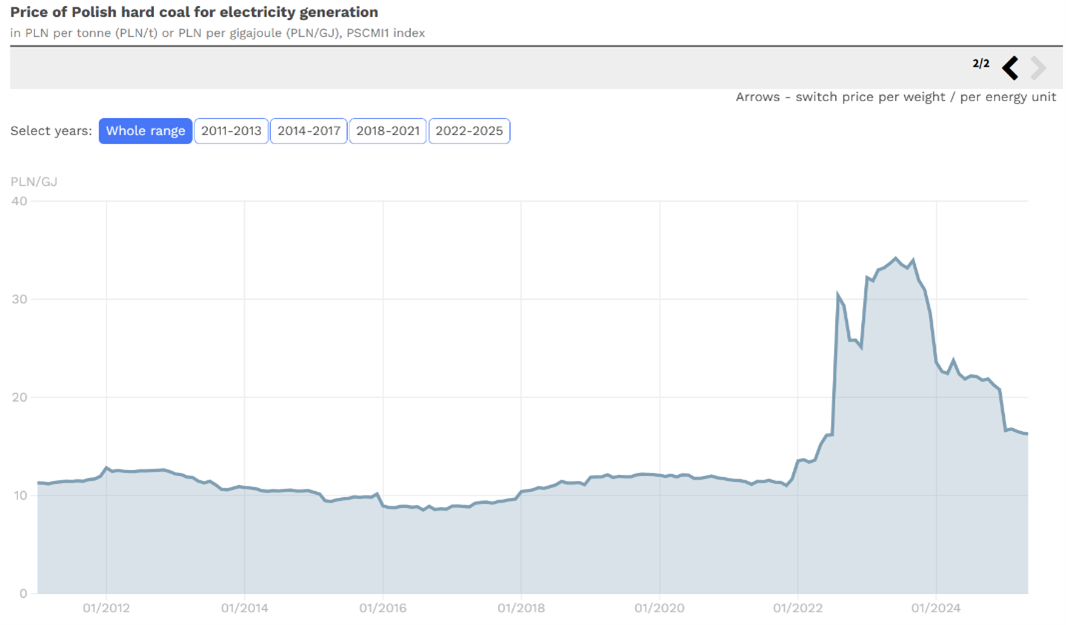

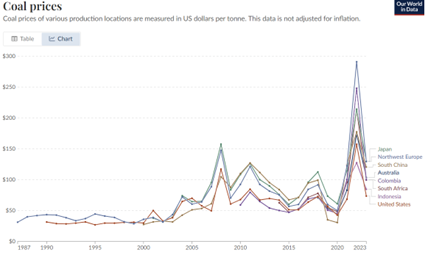
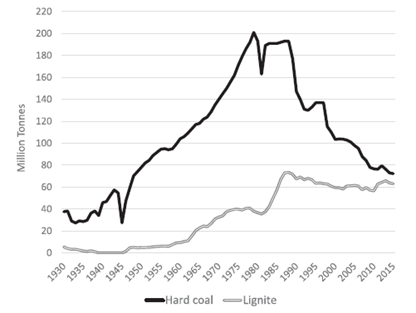
Russian coal is cheaper and higher quality. ~20% of Poland’s coal is now imported, ~75% of those coal imports come from Russia8. Prices of coal and gas have been in vacillation in recent years, following the full-scale military aggression in Ukraine. Consumers are impacted, and ongoing energy security concerns prevail, especially when there is reliance on external fuel suppliers.
Rising energy costs are also causing the gradual deterioration of the Polish domestic industry. What coal is diggable now in the country, 1km down, is more heavily mixed with heavy metals, sulphur, chlorine and hydrogen fluoride, worsening fuel emissions and impacting air quality. 40,000-50,000 Poles die prematurely each year to causes attributable to smog inhalation9.
Poland emitted ~385 million tons of greenhouse gases in 2022, 42% of which were from the energy sector10 (as much as 62% of EU’s total coal mine methane emissions in 2021 was said to be of Polish origin11). Declining quality of coal output, inefficiencies, rising costs and enormous debts – the coal industry in Poland is no longer sustainable. The country, indeed all countries, must find new pathways forward in the face of the oncoming storm that is the climate crisis.
.png)
Having devoted considerable time, human resources and arm power to hauling up billions of tonnes of amorphous carbon from the ground, the focus is now on decarbonisation – carrying on with business without insistence on incineration. In ten years, Poland has moved with alacrity, in 2016 they had ~6GW of onshore wind power, now it is ~11GW. Nearly 23GW of solar PV has also been added in the past decade, which along with some biomass and hydropower covered 29% of the country’s electricity generation in 2024.
By 2030, Poland aims to supply 56% of its energy demand by renewables12. This is admirable progress in a positive direction, yet appetite for electricity increases. Emergent AI data processing centres are ravenous for vast energy and water resources – unlike humans, their requirements for thought production cannot be satiated with a few tuna sandwiches. Electricity in greater quantities is needed for the projected electrification of sectors of the economy including heating and transport. Poland’s climatic conditions are not fit for renewables to accommodate the full anticipated demand – an estimated increase from ~150 TWH per year currently to ~318 TWh per year in 204013.
There are prolonged periods where Polish winds blow lightly, during the autumn and winter the sunlight is diminished, the rivers flow sluggishly and so the potential for large-scale hydroelectric is limited. This is not unique to Poland, Germany will also struggle to meet its full energy demand using only renewables. In addition, Poland’s coal fleet is outdated and due for decommissioning. Some power units were first put up in the 1960s, the average age of the fleet is roughly 47 years old14. Some units are older than 60 years, and have significantly outlasted their original design lifetimes.
Even if the hydropower potential of Poland was exploited to its fullest extent, this would not cover more than ~10% of current demand, and this power source wouldn’t differ much from only using solar and wind. Weather regimes get more hugger-mugger each year, the patters of the rainfall are in flux and it’s anyone’s guess whether heatwaves or floods will show up like uninvited guests to party. Domestic supply gaps in the energy system could cause large outages to occur in 2030-2040, according to current Polskie Sieci Elektroenergetyczne SA predictions15, which increases the need for large investments in alternative dispatchable sources to maintain a power reserve. High-emission baseload coal-fired capacity must be replaced with zero-emission stable and available energy generation as urgently as possible, in line with EU’s ambitious climate and energy policy16. Poland’s Energy Policy clearly indicates that Variable Renewable Energy Sources with nuclear are the trajectory for the future power system of the country.
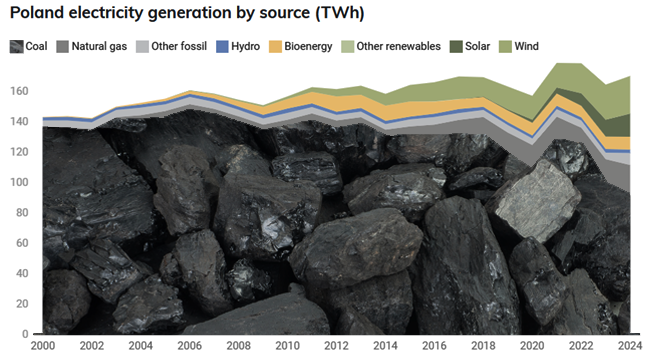
Cue the atom
Poland’s Ministry of Industry is determined to implement a multiannual Polish Nuclear Power Program (PPEJ). The first version of this strategic government document was published in 2014, with an update in 2020, and on June 25th, 2025, a draft resolution of the Council of Ministers was published18. This has been made available for public consultation (more on this below), after which the government will potentially accept and finance the program. The public can submit comments on the document until July 25, 2025. The Ministry of Industry justify the decision to go nuclear on three pillars: energy security, climate and the environment.
They state that the importance of all these areas has significantly increased due to changes in the economic and geopolitical environment – all three pillars have been wobbled in recent years and Poland strives for greater self-sufficiency. Nuclear is an advantageous technology for Poland to pursue, it has the highest energy density of other possible fuels (coal, gas, biomass, oil, hydrogen). A teaspoon of uranium is roughly comparable to a truckload of coal in terms of energy potential. It can be purchased from NATO countries, or other politically stable market economies Poland is on friendly terms with. The uranium and fuel cycle services markets are competitive, so there is no overreliance on a single monopolistic supplier. Fuel can be supplied by sea, rail, road and air, and the rods can be stored as reserves to ensure energy continuity in times of geopolitical instability and extreme weather.

Taking into the account the full cost of various factors (system, environmental, health etc.), nuclear is the cheapest source of energy available for Poland. The draft resolution makes the compelling point that nuclear is beneficial for the Polish economy as nuclear plants are not very susceptible to changes in fuel prices on the global market. The entire fuel cycle constitutes 10-15% of the total cost of energy generation in a nuclear plant. An increase in the price of the fuel by 50% would cause an increase in the cost of energy by only 6%. To compare this with natural gas, 70-80% of energy production costs are fuel costs, so major fluctuations in gas prices on the global market have a direct knock-on effect to costs. This price turbulence hinders long-term investment planning by enterprises and hampers economic development. The net result has been the acceleration of the growth of energy costs, and consumers paying more on their monthly energy bills.
Inclusion of nuclear energy in Poland’s energy policy diversifies the fuel base in the power industry, and reduces emissions of CO2 and other substances noxious to humans and environmental health – CO, NOx, SO2, dust, mercury, heavy metals and the exotic sounding polycyclic aromatic hydrocarbons (PAHs) to name but a few of the unpleasant coal emission molecules which wreak havoc on our innards, and affect babies growing in the womb.
Shifting away from coal is a positive move all round, so on a positive note Poland has commissioned the last of its coal and lignite fired power plants, and in line with EU climate policy, signed an agreement with trade unions to phase out coal mining by 204919.
Note that nuclear development is a good balancing solution for a high penetration of ‘weather-dependent’ renewables, providing inertia, dynamic voltage control capacity and other grid services where the weather is unpredictable. We recommend that these nuclear technologies should be developed in parallel with renewables, not in contradiction. A resilient power system should be a well-balanced dinner plate…
Part III
Coal to Atomic Power
Of particular delight to us good folks here at Repower Initiative, is the Polish Nuclear Energy Program’s inclusion of ‘Coal-to-Nuclear’ (C2N), and the direct shout out the draft resolution gives to the DEsire project in Poland, who get a full page around considering repowering when choosing a location for the 2nd nuclear power plant, so hats off to them. DEsire are our long-esteemed research partners, with whom we have been collaborating since the very inception of the Repowering research. The C2N idea is simple: replace coal-fired capacity with nuclear capacity, choosing locations where coal system power plants currently operate.
The benefits are systemic and socio-economic. Systemic in that existing coal infrastructure can be adapted; there are already high voltage grid connections, transport access and many other valuable buildings and pieces of kit we can reuse. Area availability and access to cooling water are also handy things to reuse. The socio-economic benefit is that for regions where aging, large system coal-fired power plants are due to be decommissioned, the post-coal transformation of the local economy must be addressed with sensitivity. Generations of workers have an identity that is intrinsically linked with coal, and fresh, pertinent job retraining schemes and investment is necessary for their future cheeriness and economic security.
The PPEJ draft resolution talks in detail of the need to maximise the participation of Polish people, entities, industries and institutions in its nuclear implementation. Poland currently has zero nuclear plants operating. It needs people to run these with the high standards of competency demanded by the international nuclear industry. Choosing existing coal regions means maintaining jobs for the many drivers, electricians, technicians and operators (amongst many other roles) who are currently employed by the coal industry – instead of abandoning these people and losing local competence, they can be retrained and become part of the new wave of energy generation. There are core team members who will operate Poland’s nuclear power in a decade who are currently high school students in their teens. Poland’s universities and educational establishments have already started to step up their educational syllabi to offer nuclear-focused programmes.
.jpg)
Poland’s first nuclear power plant will be a trio of AP1000 Westinghouse Electric Company reactors at the Lubiatowo-Kopalino location in the Choczewo commune20, on the Northern coast (see also this previous Repower article which goes into more detail on this). These will enter commercial operation and start splitting those atoms in 2033-2036. The draft PPEJ proposes a total of 6 nuclear power reactor sites, with commissions spaced out every 2-3 years21.
Preparations for the second nuclear power plant are in play, and signs are looking hopeful that Poland will join the group of countries that wish to redefine the future of post-coal regions, and that the location choice of plant No. 2 will replace an existing coal plant – although the location has not been officially decided yet. The two nuclear power plants have a planned total installed capacity of approximately 6 to 9 GWe using proven, generation III(+) large-scale (from 1000 MWe), water nuclear reactors.
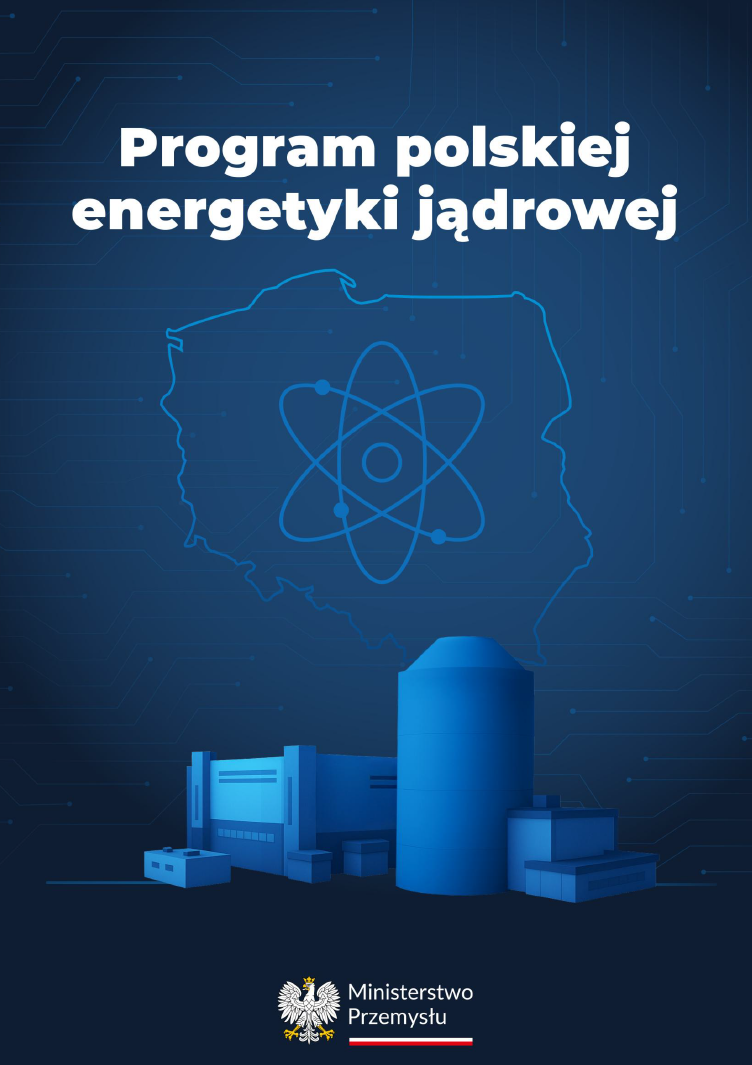
For years Coal-to-Nuclear analyses and field studies have been conducted by Polish universities and institutions, spearheaded by the DEsire – Platforma Transformacji Energetyki project, led by Łukasz Bartela, PhD, DSc with the support of the Silesian University of Technology and cooperation of Poland’s Ministry of Industry, Energoprojekt-Katowice S.A., Institute of Nuclear Chemistry and Technology, Sobieski Institute and financed by The National Centre for Research and Development. The DEsire project is in permanent collaboration with the Repower Initiative. 23 potential locations of current coal sites have been investigated as part of the forward-thinking project, with scrutiny given to environmental, technical, economic, nuclear safety and social factors. The draft PPEJ states in Section 1.3.3 – Location, that:
“One of the locations where system power plants fired with hard coal or brown coal are currently operating should be indicated for the location of the 2nd Nuclear Power Plant … as well as potential subsequent investments. Such a solution will allow for the replacement of coal-fired capacity while limiting changes in the way the National Energy System operates, and limiting the necessary investments in the expansion of the network infrastructure”22
The inclusion of this Coal-to-Nuclear pathway in the Polish Nuclear Power Program (PPEJ) is heartening and has by no means been an easy achievement. The DEsire team have presented the C2N pathway to multiple levels of decision-making entities, including ministries, local government entities, and energy groups across Poland. Publications based on our mutual work have since been cited in many important reports on the C2N decarbonisation pathway, including the significant US Department of Energy Report from 2022.
DEsire’s popularisation efforts have continued across many publications, panel discussions, and hundreds of conversations with experts and decision-makers, and we at Repower strongly believe that this new and inspired direction for Poland’s nuclear program is a direct result of the sustained research and popularisation activities of the DEsire team and Repower Initiative. Our heartfelt congratulations go to Łukasz Bartela, Staffan Qvist, Pawel Gładysz, and the entire DEsire team for their amazing accomplishments in advancing this innovative C2N pathway at the highest levels in Poland.
.jpg)
It proves that we are on the right track here with a real strategy that simultaneously tackles decarbonisation, the transformation of post-mining regions, and future clean power generation. Bełchatów, Konin, Kozienice and Połaniec are proposed locations that can gain a second life with the second national nuclear investment (subject to further detailed analysis). Small Modular Reactors (SMRs) with unit capacities of up to 500 MWe are set to roll out over the next few years. They require smaller land footprints to install, so further Coal-to-Nuclear private investments are possible and encouraged, including projects not covered by the PPEJ.
Other locations wait in anticipation – Opole, Ostrołęka, Turów… A detailed study on the 23 sites has also been published, evaluating the suitability of C2N repowering for 23 coal-fired power plants using a brownfield and direct approaches. The assessment includes separate rankings for technical feasibility and safety, in accordance with Polish nuclear regulations and International Atomic Energy Agency (IAEA) guidelines.
The methodology can serve as a valuable tool for policymakers in Poland and other countries who are assessing the feasibility of repowering coal plants with nuclear reactors – so get in touch with us if this is something you want to explore further.

As a sidenote, if you are interested in learning any more about these plants, then do head across to RepowerScore. Its our tool for expressing the suitability of a coal power plant to be repowered by an alternative technology, and is completely free to interact with. Use the ‘Power Plant search’ box on the left-hand to look up a specific plant, and find out for yourself what our analysis recommends. Bełchatów is scoring a 76/100 for site repowering using nuclear technology. Its Phase 1 Unit 2 is currently emitting a whopping 1252gCO2/kWHe. For comparison, advanced nuclear emits around 12 gCO2/kWHe. Good news that it will be retired by 2030-2036.

An aspect of Poland’s Coal-to-Nuclear inclination worthy of discussion here is district heating systems. In winters, the thermometers may drop as low as -35⁰C. The Tatra mountains will have their snow hats on, there’s a beauty to the country in the season and a tradition of Christmas markets and festivities, but the wind whips in and bites through the ciężkie kurtki (heavy jackets), and 38 million Polish people need to keep warm and cosy. Poland’s largest cities and urban areas (Warsaw, Kraków, Łódź, Poznań, Wrocław, Gdańsk) are currently heated with Combined Heat and Power Plants (CHP), ~50% of which guzzle hard coal, the rest mainly run on gas. These heating systems are some of EU’s largest, with a combined installed capacity of over 50 GWt23.
.jpg)
Coal and gas prices have risen and violently wavered in recent years, the CHP plants are aging and due for replacement in the next 10-20 years, and the EU’s Climate Policy and drive for net-zero closes off the possibility of further coal installation.
Burning biomass means felling ecosystems to make pellets – this is dreadful for the environment. Zero-emission technologies are surely the way forward, and investors’ interests have been piqued. Nuclear blocks (both SMRs and large reactors) have been proposed to use waste heat for municipal heating and industrial needs. Many European countries use nuclear heating, including Switzerland, Slovenia, the Czech Republic, Slovakia, and Hungary. A document roadmap for SMRs in Poland is in progress, to make it easier for potential investors and entrepreneurs to fund these projects.
An SMR in each city, providing 500 MW of electric power and 1500 MW of thermal heating could well be a solution here. Heating networks near to the first two nuclear projects will be analysed in agreement with local governments and heating companies. The transition to clean energy will succeed through a combination of government policy support, and private investment. The PPEJ does well to address both angles.
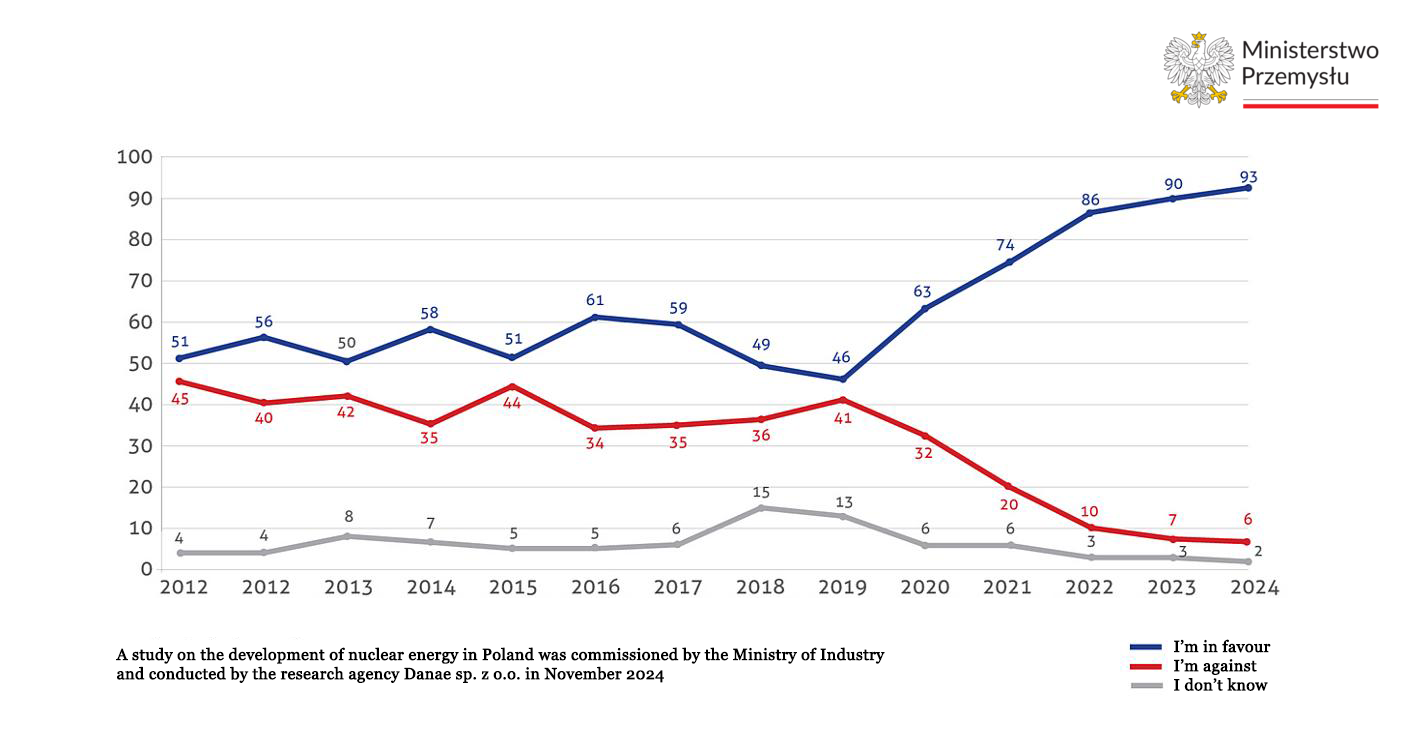
The PPEJ and period of public consultation helps to instil social trust in nuclear energy for the Polish people. A survey from November 2024 shows that 92.5% of the population is in favour of building nuclear power plants in Poland. Support has grown steadily for nuclear energy since 2019 as Polish people have recognised the need for clean, reliable energy sources to counter concerns around energy security and climate change24.
Meticulous planning, effective design with ample safety procedures and backup systems in line with international regulations are of course paramount, and the PPEJ does not scrimp on incorporating this into its content. Nuclear power has the lowest accident and mortality rate of all electricity generation technologies throughout the entire life cycle, including the production of nuclear fuel. It also has the lowest use of space per unit of electricity produced, which is good for biodiversity protection, reducing the need for further land clearance.
Management of spent nuclear fuel is addressed systemically and obligatorily across the entire life cycle in a way that rarely happens with coal globally – waste management is fully accounted for in the costing of the electricity production. Nuclear waste can be stored on the plant premises for the first 40 years of operation, and the nuclear industry has decades of experience in the deep storage of high-level waste, so Poland will have time to do it the right way.
We at Repower Initiative, in partnership with DEsire, are enthusiastic that the Polish government have woken up to the benefits of this innovative approach for their soon-to-be decommissioned coal-powered units and encourage open debate and cooperation in the public consultation process to bring the “Atom for Poland” to reality.
Part IV
Life Beyond Coal?
For those of you who are still reading – thank you for setting out on this thought journey with us! This piece could have ended at the last section. In some ways the structure of the writing here has followed a similar trajectory as the Silesian region. A historical seam has been identified and excavated to some depth, and fuel (for thought) has been garnered, but the further into the matter we get, the muckier it gets, and the more we hit into uncomfortable, difficult problems with uncertain directions forward.
It is tempting to extol the glowing virtues of this new Polish nuclear energy future beyond coal, and quietly forget about Silesia in this article, abandon further mention of the region which once proved so fruitful, and stop activities abruptly. It does an injustice to the people of Silesia to take this approach, and so let’s do better.

Sudden closures leave a turbulence in their wake, even if that is kept well out of the public eye. Change is necessary, it is the people who bear the brunt of it. For over ten centuries, Silesia has been mining and burning coal, and now less than a quarter of century remains left before all the country’s mines will be shut by 2049, in line with EU Climate Policy, which times well with the expiration of what is economically excavatable. This is the right approach for the planet and for keeping additional carbon out of the air, yet there is a precedent of how badly this can go wrong socially if handled without due care and proper planning.
In June 1989, Poland shifted from communism to democracy and a free-market economy. The state support for coal ended, dozens of uneconomic mines in Silesia closed in the 1990s, often overnight, and tens of thousands of miners were abruptly left without work. While some people were given funds and were told to start businesses, there was little guidance or support for how to go about this, and the money soon ran out, leading to social catastrophe and chaos. Workers lost jobs, friends, communities, sports clubs, wind and brass bands. Families had to relocate abroad; there was a rise in homeless children, unemployed men, and unhappy women. Poverty spread, and with it came alcoholism, depression and increased suicides. Some desperate jobless miners, had no option but illegal ‘rathole’ mines, selling coal by the bag on the black market, with zero safety regulations and extreme danger of cave ins.
Twenty years on, cities such as Wałbrzych are making positive economic recovery, and are reestablishing themselves as green, clean and tourist-friendly25, although the sub-region around Wałbrzych still has one of the highest unemployment rates in Lower Silesia, around ~7.4%26. One local resident describing the city said that there are “potholes there older than many adult citizens”. Wałbrzych in the 1990s is the poster city for how not to do a just transition.
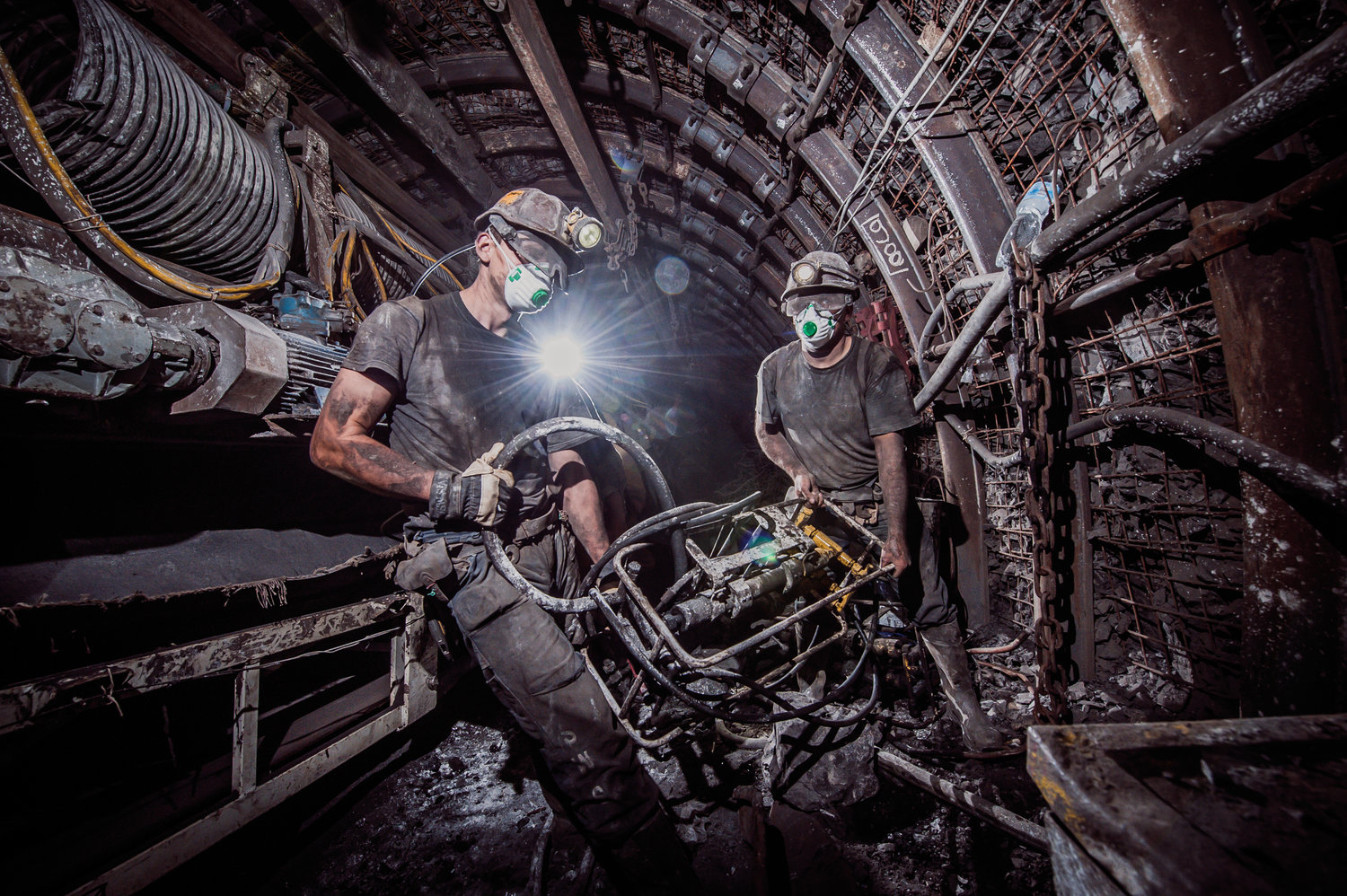
Some former coal mines in Silesia have metamorphosed to museums27, cultural and heritage centres28, conference venues or even theatres29. Local governments have helped demonstrate that there is life after coal for some building and facilities, but there is surely a saturation point of how many of these can compete for business in the region. Silesia already has a wide selection of mining museums, some of which offer novel experiences such as the chance to work a mining ‘shift’, which are apparently popular with tourist stag parties30. Without a suitable replacement industry generating wealth at scale, there will be insufficient jobs, people will emigrate, local traditions will end and the whole region could suffer. This would be an outright shame, as Silesia is a beautiful region, with its expansive forests and wildlife, and the people are hard-working, good-humoured and consistently express their love for the region and desire to see it succeed.
The issue is complicated by Silesia not being energy self-sufficient. They produce ~20 TWh and consume ~25% more. It’s a densely populated region with very little potential for VRES deployment – it is simply not windy enough. Can miners suddenly switch to become onshore wind turbine maintenance crews, commuting +100km to provinces where the wind blades rotate with more regularity? The mines are set for closure as part of the country’s decarbonisation pathway, first the thermal coal mines, then coke.
The power plants will run for a little while longer on cheap imported coal, then these too will close as they reach retirement age. It’s an old fleet. The people of Silesia have laboured hard to provide coal to provide energy for the whole country for generations, and there is a risk of them being left behind in Poland’s post-coal future.
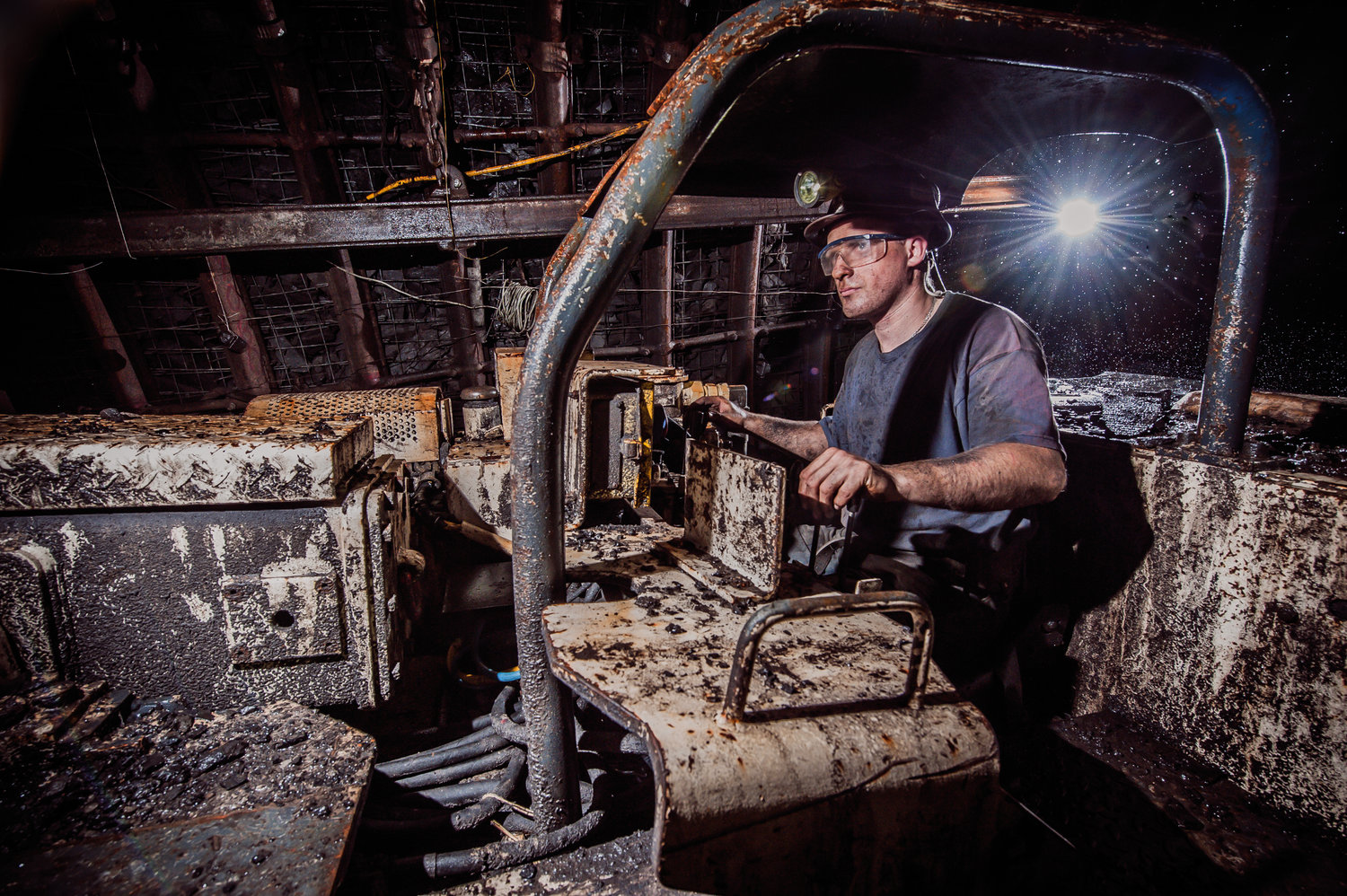
About 100 km from the borders of the Silesian agglomeration, lignite miners are hard at work, supported by excavators, some of which weigh over 7,000 tons. Across 50 years, giant holes have been gnawed into the ground that are visible from space, feeding the ever-hungry maw of Bełchatów (with an unhealthy appetite of ~45 million tonnes of lignite a year31). At a total capacity exceeding 5GW it’s the largest lignite-fired thermal power plant Europe, emitting four times as much as Ryanair’s entire fleet of passenger planes every year32 leading to an almost complete depletion of coal in the Bełchatów region due to the long and intensive supply to the insatiable power units. The 60,000 inhabitants of the city, which grew to prosperity on coal-based energy are also asking themselves the question “What next?”
.jpg)
There are no simple answers to that question.
Let us strive then for optimism and positivity. We have it in our power to engineer brilliant, abundant futures for ourselves, and to treat each other with kindness as we advance. We must explore and activate all possible solutions of low carbon technologies to cover the demand to provide electricity to all the people in Poland and do this with rapidity. This may well require a solution that blends nuclear as a baseload power with other renewables.
While no Silesian sites are currently included in the PPEJ as locations for government investment in nuclear power, there is absolutely SMR potential for savvy private investment, which generates jobs and revenue in the construction and ongoing operation.
Coal-to-nuclear is making headway in becoming established Polish policy, and this is only one of the many possible technological options available for repowering coal power, including geothermal, retrofitting plants for Thermal Energy Storage or as reuse an interconnection point for VREs, amongst many other hybrid options. All of these can provide other ways to reuse existing infrastructure and local expertise and can form the foundations of flourishing future industries. In addition to this, Poland has learned its lessons thoroughly from how Wałbrzych was handled. Poland’s Ministry of Industry are only a year into their development and already making excellent progress.
Minister Marzena Czarnecka who heads up this Ministry has said that:
“The main investment is people, and there are a lot of people employed in industry in this region. I have a goal in my heart to make their lives better and better, to have better and better memories of Upper Silesia”
They have so far shown a deep appreciation of Silesia and its heritage:
“We will show the region not only from the coal side. Above all, we want to show that there is a great potential of creative industries, energy transition and the potential of people who can work hard and find themselves in various industries. This is just the first step.” – Minister of State Assets (until May 2024) Borys Budka.33
From this region of mineral riches is springing new and conscientious policy that is a 180-degree shift from historic norms. The ground-breaking academic work of the DEsire project, and other research this has inspired, proffers new ways of continuing to use existing technological resources for peaceful future societies which are powered using clean energy. The workers of the Silesian region are resilient and strong-minded. They have proved their adaptability across turbulence, war and social and political upheavals. They are descendants of the plucky zinc smelters who made lives for themselves with copper crucibles, clay and bricks, hundreds of years ago, long before the invention of the printing press.
The capacity for human ingenuity is boundless. Our infinite creative spirit will thrive on far beyond this brief fling with coal. Repower, in collaboration with DEsire are excited to help advance the technological solutions that will get us there faster.

We are very interested in hearing your thoughts on this topic.
Get in touch with us at: news@repower.world
Sources
- https://www.pse.pl/dane-systemowe/funkcjonowanie-kse/raporty-roczne-z-funkcjonowania-kse-za-rok/raporty-za-rok-2024#r6_2
- https://www.ceicdata.com/en/indicator/poland/coal-production
- https://epub.wupperinst.org/frontdoor/deliver/index/docId/7167/file/7167_Phasing_Out_Coal.pdf
- https://www.gov.pl/web/primeminister/the-ministry-of-industry-starts-its-work
- https://www.ceicdata.com/en/indicator/poland/coal-production
- https://www.sciencedirect.com/science/article/pii/S0301420721000040
- https://www.sciencedirect.com/science/article/pii/S0301420721000040
- https://www.forum-energii.eu/en/the-end-of-energy-resource-imports-from-russia
- https://earthshotprize.org/winners-finalists/polish-smog-alert/
- https://climate.ec.europa.eu/document/download/c87bf87e-3785-46df-b270-4461814adeaa_en?filename=pl_2023_factsheet_en.pdf
- https://ember-energy.org/countries-and-regions/poland
- https://ember-energy.org/countries-and-regions/poland/
- https://strategicenergy.eu/poland-1-9-trillion-investment/
- ttps://www.researchgate.net/publication/324702423_Down_the_black_hole_Sustaining_national_socio-technical_imaginaries_of_coal_in_Poland
- https://www.pse.pl/documents/20182/32109/Ocena+wystarczalno%C5%9Bci+zasob%C3%B3w+na+poziomie+krajowym+2025+%E2%80%93+2040/2d5d0ec2-2fba-4687-81d5-9a575f22655e?safeargs=646f776e6c6f61643d74727565
- https://climate.ec.europa.eu/eu-action/european-climate-law_en
- https://ember-energy.org/data/electricity-data-explorer/
- https://www.gov.pl/web/przemysl/projekty-dokumentow-rzadowych3
- https://euracoal.eu/info/country-profiles/poland-8/
- https://netzeronuclear.org/casestudies/polands-first-ever-nuclear-power-project
- https://www.gov.pl/web/przemysl/projekty-dokumentow-rzadowych3
- https://www.gov.pl/web/przemysl/projekty-dokumentow-rzadowych3
- https://www.gov.pl/web/przemysl/projekty-dokumentow-rzadowych3
- https://www.polskieradio.pl/395/7786/artykul/3459370,vast-majority-of-poles-support-nuclear-power-plant-construction-survey
- https://www.staypoland.com/about_walbrzych.htm/
- https://op.europa.eu/en/publication-detail/-/publication/cb6a6f5a-7700-11ef-bbbe-01aa75ed71a1/language-en
- https://museumforall.eu/museum/katowice-muzeum-slaskie/
- https://kopalniaguido.pl/index.php/en/sightseeing-of-guido-coal-mine
- https://www.euronews.com/2019/10/07/coal-mines-turned-into-culture-mines-is-new-business-in-poland
- https://kopalniaguido.pl/index.php/en/mine-shift
- https://www.theguardian.com/environment/2019/sep/26/fight-power-climate-activists-europe-biggest-coal-poland-bechatow
- https://www.clientearth.org/latest/news/coal-in-europe-its-time-to-stop-digging/
- https://www.gov.pl/web/primeminister/the-ministry-of-industry-starts-its-work